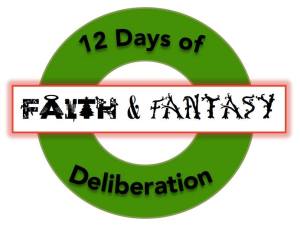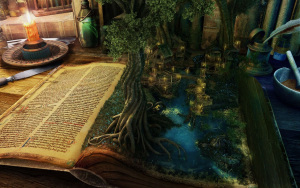Greetings, readers of Roberta! A big thank-you to my host for letting me take over her blog today. I write urban fantasies about a young woman who has –and I’m quoting from the Amazon page here – “a rare ability to counteract the supernatural by instantly neutralizing spells and magical forces.” In other words, when a vampire or werewolf steps within range of her, they become human again until they move away. I call someone with this ability a null. Roberta asked me to share how I came up with this concept and built the system of magic in my novels.
I don’t know whether other fantasy writers come up with their worlds first and then  their protagonists, but for in my case, the null idea came first. It began with my interest in a few different things: crime scenes, how the supernatural could ever stay hidden in a modern world, and of course, the movie Hellboy 2. No, seriously. There’s a sequence in that film where the characters wear special goggles that let them see the supernatural, all the things that are usually hidden from human eyes. I was fascinated by the idea of someone who could see hidden things, and for a while I worked on a main character who was a crime scene photographer.
their protagonists, but for in my case, the null idea came first. It began with my interest in a few different things: crime scenes, how the supernatural could ever stay hidden in a modern world, and of course, the movie Hellboy 2. No, seriously. There’s a sequence in that film where the characters wear special goggles that let them see the supernatural, all the things that are usually hidden from human eyes. I was fascinated by the idea of someone who could see hidden things, and for a while I worked on a main character who was a crime scene photographer.
I played with the idea for ages, but whenever I got into all the real mythology questions, I kept running into problems. More importantly, the more I developed the character, the less I was able to connect with her. Runa was a little too squeaky-clean and cheerful for me to spend a whole book inside her head. I had hit a wall. Back to the drawing board.
 While I was researching crime scenes, however, there was another set of images that kept popping into my head: scenes from the short-lived 2007 television show Moonlight. Within that show’s mythology, whenever there was supernatural evidence, you could call a phone number and this group of uber-tough women would show up to clean it for you. As I remember them (granted, this was six years ago) those cleaners were classic screen badasses: black catsuits, leather, dangerously high ponytails, eyeliner to kill, the works. I thought they were a bit cartoonish, but I was very taken with the idea of the crime scene cleaner. Who were these women? I wondered. How did they get the gig cleaning up after other people’s messes? Why would they be invested in it? And why would they wear black leather catsuits?
While I was researching crime scenes, however, there was another set of images that kept popping into my head: scenes from the short-lived 2007 television show Moonlight. Within that show’s mythology, whenever there was supernatural evidence, you could call a phone number and this group of uber-tough women would show up to clean it for you. As I remember them (granted, this was six years ago) those cleaners were classic screen badasses: black catsuits, leather, dangerously high ponytails, eyeliner to kill, the works. I thought they were a bit cartoonish, but I was very taken with the idea of the crime scene cleaner. Who were these women? I wondered. How did they get the gig cleaning up after other people’s messes? Why would they be invested in it? And why would they wear black leather catsuits?
I don’t remember the exact light bulb moment, but at some point it all came together for me. What if instead of seeing the supernatural, my protagonist undid it? And what if she used that odd skill set to clean up after the smarmy-ass vampires who ran around doing whatever they wanted?
And as soon as I put those ideas together, it was like a switch had flipped. Scarlett was born, fully-formed in my mind. She wasn’t a classic screen badass, or a cartoon, or cheerfully optimistic about life. She was moody and withdrawn and sarcastic. She was frozen in place, underappreciated, apathetic, and deeply, deeply noble. She had a lot of growing up to do, and more than anything, she needed someone to give her the chance to do it.
(Fun fact: I didn’t give up on Runa the crime scene photographer. I brought her back in book two as a romantic foil for Scarlett. She ended up having a much bigger part in the story than I’d first planned, and she’ll even make an appearance in book 3.)
But when I decided who Scarlett was, and what she could do, I was really just getting started. I still had to figure out the rules of the world around her, and guys, that is hard. Worldbuilding is hard. But I needed to work out how magic worked, and why nulls could undo it. I spent a long time considering where Scarlett’s powers might come from, and what would set my world apart from other urban fantasies. Then I had to make it all fit together in a way that made some kind of logical sense. (This process mostly involved explaining my ideas to my husband, who has a knack for immediately poking a hole in a plot problem. Then I’d try to fix that hole, take it back to him, and he’d poke another. Repeat.) Here are the rules that I eventually came up with for Scarlett’s universe:
1. There is no other place. No Never-never, no alternate dimensions, no Heaven or Hell. There is only here.
2. To that end, there are no angels or demons. They do not exist – or at least, they don’t exist any more than they do in reality.
3. Magic is everywhere; a component of nature, a force of life. It’s not exactly the same, but if I had to compare it to an existing mythology, the one that comes closest is probably The Force.
4. Because magic is a force (small letter f), it has interacted with and affected evolution for millions of years. Evolution in general is a huge part of my mythology. (There’s more about this in A Brief History of Magic, which you can find on my website.)
5. There is something wrong with magic. For the last few hundred years or so, it had begun to fade, to die. (I know why, but I’m not telling you. That’s a mystery for later.) Around the time that magic began to fade, nulls began to appear on the supernatural scene.
6. There is no ruling leader, group, or organization for the supernatural world, which I call the Old World in my books. Although we live in a digital age, the world of magic is still stuck in a mindset that’s similar to the one used for settling the American West: you stake out an area and try to hold it. You have your own rules for within that area, and your own way of doing things. The world is too big, and the supernatural is too secret, for global or even national leadership.
7. There is only one law that applies globally to all of the Old World: thou shall never tell humans about the Old World. Humans who find out have to be either killed or converted. Since there is now something wrong with magic, which makes it less likely for someone to be able to become a vampire or werewolf, this rule has occasionally been relaxed a tiny bit when a human is particularly useful – but only for whoever’s in charge of that region.
There are, of course, a hundred other details about how things work, but these were the laws that I started with when I began Dead Spots. And they’re working for me – after the third book, Hunter’s Trail (fall 2014), I’ll be writing another book set in Scarlett’s universe, but with a different protagonist. I hope she’ll be every bit as fun to write as Scarlett has been.
~~~
Melissa F. Olson was born and raised in Chippewa Falls, Wisconsin, and studied film and  literature at the University of Southern California in Los Angeles. After graduation, and a brief stint bouncing around the Hollywood studio system, Melissa moved to Madison, Wisconsin, where she eventually acquired a master’s degree from the University of Wisconsin–Milwaukee, a husband, a mortgage, two kids, and two comically oversize dogs—not at all in that order. She is the author of Dead Spots, Trail of Dead, and the upcoming Hunter’s Trail.
literature at the University of Southern California in Los Angeles. After graduation, and a brief stint bouncing around the Hollywood studio system, Melissa moved to Madison, Wisconsin, where she eventually acquired a master’s degree from the University of Wisconsin–Milwaukee, a husband, a mortgage, two kids, and two comically oversize dogs—not at all in that order. She is the author of Dead Spots, Trail of Dead, and the upcoming Hunter’s Trail.
To learn more about Melissa and her books, visit her website: http://www.MelissaFOlson.com




 literature at the University of Southern California in Los Angeles. After graduation, and a brief stint bouncing around the Hollywood studio system, Melissa moved to Madison, Wisconsin, where she eventually acquired a master’s degree from the University of Wisconsin–Milwaukee, a husband, a mortgage, two kids, and two comically oversize dogs—not at all in that order. She is the author of Dead Spots, Trail of Dead, and the upcoming Hunter’s Trail.
literature at the University of Southern California in Los Angeles. After graduation, and a brief stint bouncing around the Hollywood studio system, Melissa moved to Madison, Wisconsin, where she eventually acquired a master’s degree from the University of Wisconsin–Milwaukee, a husband, a mortgage, two kids, and two comically oversize dogs—not at all in that order. She is the author of Dead Spots, Trail of Dead, and the upcoming Hunter’s Trail.













